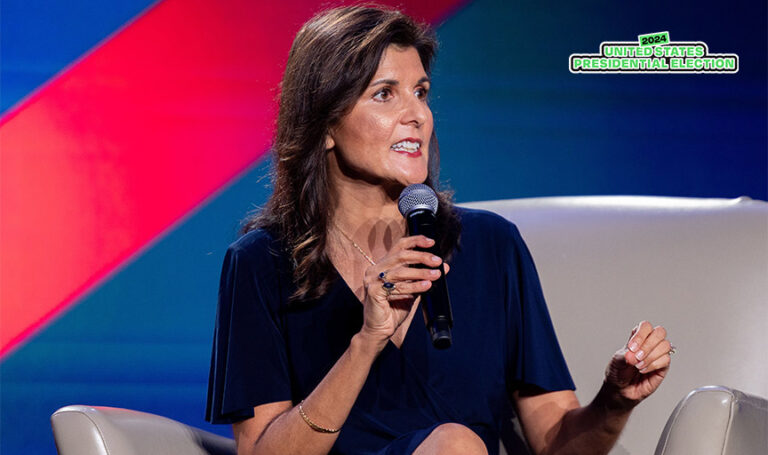From its lack of popularity with young voters to the Nikki Haley wild card, the GOP has had a tough week

Welcome to week 4 of our weekly recaps with everything you need to know about the 2024 US presidential election. It’s safe to say that the past seven days have been full of political drama, from the Republican Party’s increasing attempts to block students from voting to Ron DeSantis’ bizarre “human faeces” stunt during a televised debate with Gavin Newsom, and all the way down to Nikki Haley’s progress in going after Trump.
Students, a force to be reckoned with
In a political landscape marked by constant evolution, an unexpected force is gaining prominence within the Grand Old Party (GOP)—students. Traditionally aligned with progressive ideals, young voters are now a focal point in the party’s strategy. During a spring special election, Dane County, home to the University of Wisconsin, saw an impressive turnout of almost a quarter million voters, surpassing the number in Milwaukee, a county with nearly double Dane’s population.
Notably, 82 per cent of Dane voters passionately supported liberal Judge Janet Protasiewicz in her bid for the state Supreme Court. The outcome was an 11-point victory for Protasiewicz, which adds significance as her vote could sway the court’s decision on gerrymandering.
The GOP, already reeling from Wisconsin’s lead in youth turnout during the 2022 midterms, faced a stark awakening with the April defeat. Former Wisconsin Governor Scott Walker bluntly acknowledged, “Young people are the issue,” emphasising the need for a strategic shift to win elections. Walker’s historical involvement, including signing a law that restricted the use of student IDs for voting, reflects a long-standing awareness of the power wielded by young voters.
Younger voters are the issue.
— Scott Walker (@ScottWalker) April 6, 2023
It comes from years of radical indoctrination - on campus, in school, with social media, & throughout culture. We have to counter it or conservatives will never win battleground states again. @yaf pic.twitter.com/eG0pt3w8hk
Despite the evident surge in student engagement in Wisconsin over the years, the GOP appears undeterred, continuing to employ tactics aimed at limiting student voters. This aligns with a broader national trend, where targeted endeavours to disenfranchise student voters have gained momentum, driven by the realisation of the bloc’s crucial role in securing Democratic victories. While these efforts had mixed success in 2023, they are expected to intensify in 2024, underscoring the growing apprehension among Republican officials and strategists regarding the influence of young voters.
Ron DeSantis’ unconventional tactics: Maps, socks, and political messaging
Governor Ron DeSantis recently exemplified this shift with a unique attempt to discredit California Governor Gavin Newsom, involving an argument on “human faeces.” Using maps and visual aids, DeSantis underscored challenges faced by cities like San Francisco, signalling the GOP’s acknowledgement of the need to connect with younger demographics and challenging traditional narratives.
The recent televised debate between DeSantis and Newsom showcased the Florida governor’s unapologetic and unconventional approach to political discourse. Holding up a map highlighting human faeces on San Francisco streets, DeSantis criticised California’s management of homelessness and crime. This visual tactic, coupled with the sale of satirical socks called “Newsom’s California Walking Socks,” marks a departure from traditional political messaging.
While DeSantis’ tactics may seem eccentric, they align with a broader trend in modern politics, where visuals and memorable symbols play a crucial role in shaping public perception. His approach raises questions about the changing nature of political communication within the GOP and the lengths politicians are willing to go to capture attention and make a statement.
@kenneth.green88 Incase you missed it......... It's funny all that idiot Gavin Newsom could do is Laugh Ron DeSantis is right .... DeSantis holds up a map of human feces in San Francisco: "Human feces is now a fact of life, except when a communist dictator comes to town. Then they cleaned up the streets
♬ original sound - Kenneth Green
Nikki Haley's billion-dollar gamble: Koch network’s endorsement
In the intricate web of US politics, another significant narrative has unfolded this week—Nikki Haley’s billion-dollar gamble. Positioned as a pivotal figure in the GOP’s 2024 presidential bid, Haley receives a game-changing endorsement from the influential Koch network, less than 50 days before voting starts. This endorsement, accompanied by substantial financial backing, positions Haley as a potential alternative to Donald Trump.
Koch Network’s endorsement injects considerable resources into Haley’s campaign, departing from conventional GOP endorsements. The move carries implications for the party’s internal dynamics and sheds light on the challenges of competing against a political giant like Trump. As Haley aims to carve a path distinct from Trump’s influence, the billion-dollar gamble prompts broader questions about the GOP’s ideological direction and the role of major donors in shaping party politics.
Bolstered by a strategic campaign, a fresh generational message, and commendable debate performances, Haley is gaining traction as a Trump alternative.
However, despite the substantial support from the Koch-affiliated group, which boasts significant financial resources and a robust political apparatus, this endorsement raises pertinent questions for Haley, who is navigating the challenging terrain of breaking the highest glass ceiling in politics as a woman.
One crucial question is whether this late-stage boost will position Haley as one of the best-financed runners-up in US political history, or if she can leverage it to mount a formidable challenge to the ex-president. The endorsement introduces a dynamic element, potentially creating conditions under which Trump, who currently enjoys a substantial lead in GOP primary polls, could face a credible challenger. This shift might accelerate Haley’s ascent, potentially overshadowing competitors like DeSantis and former New Jersey Governor Chris Christie.
As the 2024 presidential election approaches, the GOP finds itself at a critical juncture, balancing tradition with innovation, and navigating a political landscape where students, visuals, and financial backing play pivotal roles. The coming months will reveal whether these emerging dynamics reshape the party’s identity and influence its trajectory in the years to come.





